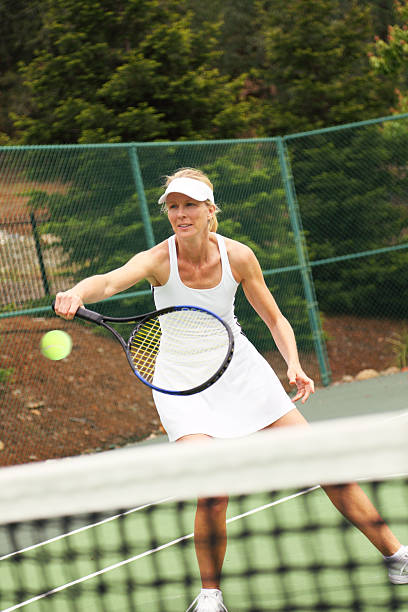
Over the years, I have learned that city tennis leagues like the Atlanta Lawn and Tennis Association, and the United States Tennis Association have some of the most competitive athletes I have ever worked with.
Women ranging in age from their early 40’s to their mid 70’s, who are very active, and who simply put, like to win, and don’t like to lose.
Just as any other elite athlete has a specific training regimen to give them a competitive advantage on the courts, there are specific training measures that you can take as well if you are in that age bracket and are still competitive in your tennis league.
Regardless of age, the motions of tennis, joints used, muscle contraction forces are the same, just maybe at different velocities.
Training the joints and muscles involved in creating and ACE serve, or running to the ball to return a volley can not only improve your efficiency of movement, but can also help reduce nagging injuries that you may be dealing with.
The below exercises address strength at the ankle, trunk and spine (core), and knee strength.
Here are three simple exercise that you can implement into your off court training routine to improve your tennis game and leave your competitors wondering how in the world is she moving so well:
1.) Dorsi Flexion: Ankle Strength
It all starts at the feet and ankle. One of the more common injuries among tennis players are rolled ankles, and calf strains. This can happen for multiple reasons, such as stiff ankles, “tight” calves, even the type of shoes you are wearing. One thing that is certain is that training the ankle joint, specifically ankle flexion, can help prevent injury, and help you to change direction more quickly.
All you need is a light kettle bell, and a bench.
Intention: The purpose here is to strengthen the flexors of the foot. This motion is important for the initial “push off” when accelerating, and also decelerating. The stronger the flexors are, the more force you can generated, and the more force you can stop, like your body weight.
This exercise can also be done by securing a resistant band around a solid point, and looping it around the distal part of your foot.
Kettel Bell Dorsi Flexion from Coach Willis on Vimeo.
2.) Reverse Band Lift
Having a strong core comes into play when not only hitting a tennis ball, but running as well. In order to be able to connect solidly with the ball, you should have good rotational strength.
The reverse band lift is one of the many rotational exercises that we utilize for our tennis athletes, as well as general fitness members in order to strengthen the trunk rotators. All you need is a light resistant band, and a solid anchor point.
Intention: Th purpose of this exercise is to strengthen the deeper muscles involved in rotating from a low to a higher level. This not only works the muscles closer to the spine, but also the glute and lower back muscles, which play a key role in stabilization throughout the movement.
Make sure to concentrate on keeping your elbows locked in order to isolate the trunk, and inhibit use of the arms in moving the band.
3.) Split Squat with Anterior Pull (Deceleration)
Sprinting, getting to the ball, slowing down to position your self lower to hit the ball involves rapidly moving and stopping your bodyweight. The primary areas responsible for that are the ankle, glute, knee, and quads.
The split squat is a great exercise to do in order to train those muscles involved in rapid deceleration.
Here is a variation using a light resistant band using accommodating resistance and providing an additional force to work against during the movement. The purpose is to simulate the additional forces across the targeted muscles and joints that are at work when coming to a rapid stop.
The second variation targets the same, with an additional “push off” and stabilization action to train better reacceleration after stopping.
Intention: More control on deceleration, and redirection. Strengthen quad, glute, knee, and ankle.
Try implementing these at your gym, or at home for a few weeks to help get you a competitive edge in your tennis league. Play to dominate!
If you or a friend play at a competitive level in your ALTA and USTA tennis league, have minor injuries you deal with, or want to sharpen your competitive edge, visit our Athlete Development page here to learn more, give us a call at this number 770-691-1392, OR email me at coachwillis@willisperformance.com.
